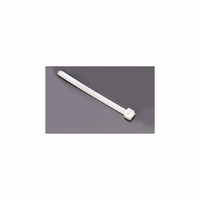PLT.7M-C Panduit Corp, PLT.7M-C Datasheet - Page 62

PLT.7M-C
Manufacturer Part Number
PLT.7M-C
Description
TIE CABLE PAN-TY 18LB 3.1"
Manufacturer
Panduit Corp
Series
PAN-TY®r
Type
Pan-Tyr
Specifications of PLT.7M-C
Wire/cable Tie Type
Standard, Locking
Bundle Diameter
0.68" (17.27mm)
Length
0.258' (78.74mm, 3.10")
Width
0.090" (2.30mm)
Mounting Type
Free Hanging (In-Line)
Tensile Strength
18 lbs. (8.2 kg)
Color
Natural
Cable Tie Length
3.1"
Cable Tie Width
0.09"
Body Material
Nylon 6.6
Tensile Strength Pounds
18lb
Cable Bundle Diameter Min
0.8mm
Cable Bundle Diameter Max
0.68"
Maximum Bundle Diameter
0.68 in
Product
Cable Ties
Application
For indoor use
Height
0.115" (Head)
Protection Class
Tie, Cable
Special Features
Locking
Operating Temp Range
-40C to 85C
Product Length (mm)
79mm
Product Depth (mm)
4.6mm
Product Height (mm)
2.9mm
Accessory Type
Locking Cable Tie
Rohs Compliant
Yes
Lead Free Status / RoHS Status
Lead free / RoHS Compliant
Features
-
Lead Free Status / Rohs Status
Lead free / RoHS Compliant
Other names
298-1018
62
Selecting the Proper Cable Tie Material for Your Application
Example No. 1:
Example No. 2:
Part Number Suffix
Material Designation
Loop Tensile Strength
Low Temperature Service
High Temperature Service
Flammability
Ultraviolet Resistance
Radiation Resistance
Overall Chemical Resistance
–Hydrocarbons
–Chlorinated Hydrocarbons
–Acids
–Bases
–Salts
Relative Price
If the application requires a low cost material, good ultraviolet resistance and good
resistance to acid rains.
If the application requires high radiation (2 x 10
resistance to hydrocarbons and the price is not critical.
By using this information as a guide, the user will be better equipped to select the best suited cable tie
and material to perform its intended function over a long period of time.
For long life and dependable service, there are many factors to consider when selecting the proper cable
tie for each application. Since it is impossible for PANDUIT
combinations of conditions which may arise, it is suggested that this data be used as a guide. Sample
cable ties should be tested under actual end-use conditions to determine the correct cable tie for
the application.
To select the optimum cable tie for a specific application, the following table can be used as a quick
reference. First, determine the most critical design criteria and then read across the table to find which
material is most suitable to meet this need (10 = Most Suitable and 1 = Least Suitable). Next, review the
other criteria by scanning in a vertical direction on the chart and then make your final selection.
Design Criteria
Most commonly used parts appear in BOLD.
Cable Tie Selection and Specification Guidelines
Application
Application
Low
7
6
5
6
1
3
6
9
7
2
7
3
Low
-0
7
6
5
6
6
3
6
9
7
2
7
3
8
rads) resistance, excellent
Low
-30
7
6
6
6
4
3
6
9
7
2
7
3
Low
-39
7
6
6
6
1
3
6
9
7
2
7
3
Med.
-300
7
6
6
6
6
3
6
9
7
2
7
3
Med.
-60
The best choice is weather resistant polypropylene. Cost is low; it has a rating of 6
The best choice is TEFZEL*** or stainless steel. The price is higher than other
materials, but both have high ratings in resistance to radiation and hydrocarbons.
in ultraviolet resistance and a rating of 9 in resistance to acids.
7
5
5
8
1
3
6
9
7
2
7
3
Med.
®
-69
5]
7
5
8
1
3
6
9
7
2
7
3
to provide data on all the various
*See page 70
Med.
-120
6
6
5
3
7
4
8
9
8
6
7
8
*** TEFZEL is a registered trademark of E. I. DuPont de Nemours Co.
-109
Low
10
5
6
5
2
1
5
8
6
5
9
9
(Table C) for chemical resistance of 304 & 316 stainless steel.
** HALAR is a registered trademark of Solvay Solexis, Inc.
Selection
Selection
-100
Low
10
5
6
5
2
6
5
8
6
5
9
9
High
-76
10
10
10
10
10
10
7
7
8
9
9
9
High
-702
10
10
10
10
10
10
5
7
7
9
9
9
Med.
N/A
9
6
3
2
9
3
5
9
8
2
2
4
High
10
10
10
10
10
10
10
10
10
9
8
9










